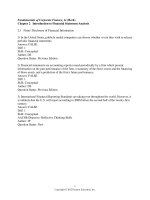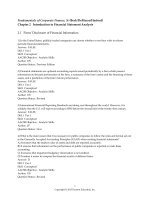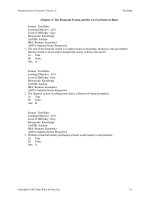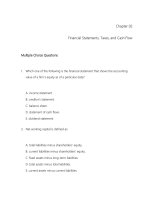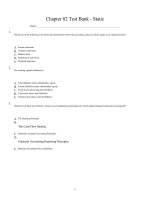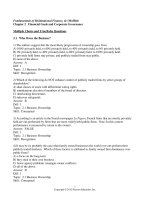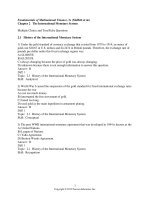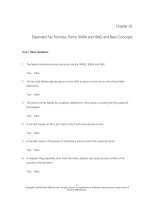Fundamentals of corporate finance 7th edition brealey test bank
Bạn đang xem bản rút gọn của tài liệu. Xem và tải ngay bản đầy đủ của tài liệu tại đây (253.59 KB, 53 trang )
Chapter 02 - Financial Markets and Institutions
Chapter 02
Financial Markets and Institutions
True / False Questions
1. The reinvestment of cash back into the firm's operations is an example of a flow of savings to
investment.
True False
2. Smaller businesses are especially dependent upon internally generated funds.
True False
3. An individual can save and invest in a corporation only by lending money to it or by
purchasing additional shares.
True False
4. Apple Computer is well known for its product innovations. Access to financing was not vital
to Apple's growth and profitability.
True False
5. Hedge fund managers, unlike mutual fund managers, do not receive
fund-performance-related fees.
True False
6. In the United States, banks are the most important source of long-term financing for
businesses.
True False
2-1
Chapter 02 - Financial Markets and Institutions
7. A financial intermediary invests in financial assets rather than real assets.
True False
8. Only small companies can go through financial markets to obtain financing.
True False
9. Previously issued securities are traded among investors in the secondary markets.
True False
10. Only the IPOs for large corporations are sold in primary markets.
True False
11. The markets for long-term debt and equity are called capital markets.
True False
12. The stocks of major corporations trade in many markets throughout the world on a
continuous or near-continuous basis.
True False
13. The derivative market is also a source of financing.
True False
14. Households hold more than half of U.S. corporate equities.
True False
2-2
Chapter 02 - Financial Markets and Institutions
15. The key to the banks' ability to make illiquid loans is their ability to pool liquid deposits
from thousands of depositors.
True False
16. For corporate bonds, the higher the credit quality of an issuer, the higher the interest rate.
True False
17. The cost of capital is the interest rate paid on a loan from a bank or some other financial
institution.
True False
18. Like public companies, private companies can also use their stock price as a measure of
performance.
True False
19. The opportunity cost of capital is the expected rate of return that shareholders can obtain in
the financial markets on investments with the same risk as the firm's capital investments.
True False
20. Whenever there is uncertainty, investors might be interested in trading, either to speculate
or to lay off their risks, and a market may rise to meet the trading demand.
True False
21. Financial markets and intermediaries allow investors and businesses to reduce and
reallocate risk.
True False
2-3
Chapter 02 - Financial Markets and Institutions
22. The cost of capital is the minimum acceptable rate of return for capital investment.
True False
23. The rates of return on investments outside the corporation set the minimum return for
investment projects inside the corporation.
True False
24. Financing for public corporations must flow through financial markets.
True False
25. Financing for private corporations must flow through financial intermediaries.
True False
26. Almost all foreign exchange trading occurs on the floors of the FOREX exchanges in New
York and London.
True False
27. During the Financial Crisis of 2007-2009, the U.S. government bailed out all firms in
danger of failing.
True False
28. From June 2001 to June 2006, housing prices in the United States doubled.
True False
29. The effects of the financial crisis of 2007-2009 were confined to the U.S. and domestic
companies.
True False
2-4
Chapter 02 - Financial Markets and Institutions
30. One root of the financial crisis of 2007-2009 was the strict money policies promoted by the
U.S. Federal Reserve and other central banks after the technology bubble burst (i.e., money was
relatively expensive during this time).
True False
Multiple Choice Questions
31. Corporate financing comes ultimately from:
A. savings by households and foreign investors.
B. cash generated from the firm's operations.
C. the financial markets and intermediaries.
D. the issue of shares in the firm.
32. A company can pay for its expansion in all the following ways except:
A. by using the earnings generated from its sale of obsolete equipment.
B. by persuading the director's mother to make a personal loan to the company.
C. by purchasing bonds in the secondary market.
D. by selling stock certificates for a new subsidiary.
33. "Reinvestment" means:
A. new investment in new operations.
B. additional investment in existing operations.
C. new investment by new shareholders.
D. additional investment by existing shareholders.
34. Excess cash held by a firm should be:
A. reinvested by the firm in projects offering the highest rate of return.
B. reinvested by the firm in projects offering rates of return higher than the cost of capital.
C. reinvested by the firm in the financial markets.
D. distributed to bondholders in the form of extra coupon payments.
2-5
Chapter 02 - Financial Markets and Institutions
35. A financial intermediary provides financing for:
A. individuals.
B. companies.
C. other organizations.
D. all of these.
36. Which of the following statements is not characteristic of mutual funds?
A. They are financial institutions.
B. They raise money by selling shares to investors.
C. They pool the savings of many investors.
D. They offer professional management.
37. Compared to buying stocks and bonds directly, what are the advantages of investing in a
mutual fund?
A. Mutual funds are efficiently diversified and professionally managed.
B. Investment returns are never taxed until withdrawn from the fund.
C. You can buy additional shares in the fund or cash out at any time.
D. All of these.
38. "Balanced" mutual funds:
A. offer mixtures of stocks and bonds.
B. spread their investments equally over a specified geographic area.
C. spread their investments equally over various industries.
D. charge a management fee that is proportionate to the investment return.
39. Which of the following mutual funds have a tax advantage?
A. Balanced funds
B. Pension funds
C. Bond funds
D. Funds that invest in foreign countries
2-6
Chapter 02 - Financial Markets and Institutions
40. Banks cover the costs of the service they provide primarily via:
A. a management fee.
B. a service charge.
C. an interest rate differential.
D. an operating fee.
41. Which of the following financial intermediaries has shown a preference for investing in
long-term financial assets?
A. Commercial banks
B. Insurance companies
C. Finance companies
D. Savings banks
42. Which of the following financial intermediaries can loan money directly to businesses?
A. Mutual funds
B. Pension funds
C. Insurance companies
D. All of these
43. Insurance companies can usually cover the claims of policyholders because:
A. the incidence of claims normally averages out.
B. they issue thousands of insurance policies.
C. the cost of paying for claims has already been factored into the price of the policies.
D. all of these.
44. Which of the following is not typically considered a function of financial intermediaries?
A. Providing a payment mechanism
B. Investing in real assets
C. Accumulating funds from smaller investors
D. Spreading, or pooling risk among individuals
2-7
Chapter 02 - Financial Markets and Institutions
45. U.S. bonds and other debt securities are mostly held by:
A. institutional investors.
B. households.
C. foreign investors.
D. state and local governments.
46. Liquidity is important to a mutual fund because:
A. a fund that is less liquid will attract more investors.
B. the fund's shareholders may want to redeem their shares at any time.
C. the fund's managers need liquidity to trade actively.
D. the fund needs to distribute payouts to its shareholders and managers periodically.
47. Property insurance companies protect themselves against the extensive damage caused by
hurricanes and earthquakes by:
A. selling thousands of policies to different homeowners.
B. factoring the cost into the price of the policies.
C. buying reinsurance against such catastrophes.
D. declaring bankruptcy when the need arises.
48. Financing for public corporations flows through:
A. the financial markets only.
B. financial intermediaries only.
C. derivatives markets.
D. the financial markets, financial intermediaries, or both.
49. When corporations need to raise funds through stock issues, they rely on the:
A. primary market.
B. secondary market.
C. tertiary market.
D. centralized NASDAQ exchange.
2-8
Chapter 02 - Financial Markets and Institutions
50. A primary market would be utilized when:
A. investors buy or sell existing securities.
B. shares of common stock are exchanged.
C. securities are initially issued.
D. a commission must be paid on the transaction.
51. The primary distinction between securities sold in the primary and secondary markets is
the:
A. riskiness of the securities.
B. price of the securities.
C. previous issuance of the securities.
D. profitability of the issuing corporation.
52. Which of the following are both a financial intermediary and a financial institution?
A. Mutual funds
B. Pension funds
C. Insurance companies
D. Hedge funds
53. A share of IBM stock is purchased by an individual investor for $75 and later sold to
another investor for $125. Who profits from this sale?
A. IBM.
B. The first investor.
C. The second investor.
D. Profit is split between IBM and the investor.
54. Which of the following financial assets might be least likely to have an active secondary
market?
A. Common stock of a large firm
B. Bank loans made to smaller firms
C. Bonds of a major, multinational corporation
D. Debt issued by the U.S. Treasury
2-9
Chapter 02 - Financial Markets and Institutions
55. When Patricia sells her General Motors common stock at the same time that Brian
purchases the same amount of GM stock, GM receives:
A. the dollar value of the transaction.
B. the dollar amount of the transaction, less brokerage fees.
C. only the par value of the common stock.
D. nothing.
56. Which of the following financial markets is in one centralized location?
A. NYSE
B. NASDAQ
C. The over-the-counter market
D. The European Monetary Union
57. Which of the following financial markets is not located in one centralized location?
A. NYSE
B. LSE
C. NASDAQ
D. CBOT
58. Corporate debt instruments are most commonly traded:
A. on the NYSE.
B. on NASDAQ.
C. in the money market.
D. in the over-the-counter market.
59. A bond differs from a share of stock in that:
A. a bond represents a claim on the firm.
B. a bond has more risk.
C. a bond has guaranteed returns.
D. a bond has a maturity date.
2-10
Chapter 02 - Financial Markets and Institutions
60. Short-term financing decisions commonly occur in the:
A. primary markets.
B. secondary markets.
C. capital markets.
D. money markets.
61. Long-term financing decisions commonly occur in the:
A. option markets.
B. secondary markets.
C. capital markets.
D. money markets.
62. You can buy silver in the:
A. capital markets.
B. foreign exchange markets.
C. commodities markets.
D. option markets.
63. Commodity and derivative markets:
A. are sources of financing.
B. enable the financial manager to adjust the firm's exposure to various business risks.
C. are always over-the-counter markets.
D. all of these.
64. A financial institution:
A. is a kind of financial intermediary.
B. simply pools and invests savings.
C. raises financing by selling shares or policies.
D. invests primarily in commodities.
2-11
Chapter 02 - Financial Markets and Institutions
65. U.S. corporate equities are mostly held by:
A. insurance companies.
B. households.
C. foreign investors.
D. state and local governments.
66. In 2010, U.S. corporate and foreign bonds totaled:
A. less than $500 billion.
B. about $3 trillion.
C. about $7 trillion.
D. more than $11 trillion.
67. In 2010, U.S. corporate equities totaled:
A. less than $6 trillion.
B. about $10 trillion.
C. about $16 trillion.
D. more than $20 trillion.
68. An example of how financial intermediaries can assist in shifting an individual's
consumption to the future is:
A. lending money to the individual.
B. providing a checking account.
C. opening a savings account.
D. requiring purchases to be in cash.
69. An example of how financial intermediaries can assist in shifting an individual's
consumption forward in time is:
A. providing a line of credit.
B. opening a passbook account.
C. starting a life insurance policy.
D. starting an auto insurance policy.
2-12
Chapter 02 - Financial Markets and Institutions
70. One reason suggesting that banks may be better than individuals at matching lenders to
borrowers is that banks:
A. can shift loan risk to their deposit customers.
B. are motivated by the potential for profit.
C. do not have any income tax liability.
D. have information to evaluate creditworthiness.
71. Which of the following is least liquid?
A. Foreign currency
B. U.S. Treasury bonds
C. Rare coins
D. Savings deposit
72. Financial markets and intermediaries:
A. channel savings to real investment.
B. enable investors and businesses to reduce risk.
C. provide liquidity.
D. all of these.
73. Which of the following functions does not require financial markets?
A. Transporting of cash across time
B. Provision of liquidity
C. Risk reduction by investment in diversified portfolios
D. Provision of trade information
74. For the consumer, a credit card:
A. transports money forward in time.
B. provides liquidity.
C. is a convenient way to pay.
D. all of these.
2-13
Chapter 02 - Financial Markets and Institutions
75. Which of the following actions does not help reduce risk?
A. Extending the service warranty for your notebook
B. Converting your money market account to a mutual fund account
C. Contracting to sell your farm produce to the neighborhood grocery
D. Buying Japanese yen now when you plan to study in Japan next year
76. Which of the following information is not provided by the financial markets?
A. The price of six ounces of gold
B. The cost of borrowing $500,000 for 5 years
C. Microsoft's earnings in 2002
D. The cost of wiring one million yen to Japan
77. The opportunity cost of capital:
A. is the interest rate that the firm pays on a loan from a financial institution.
B. is the maximum acceptable rate of return on a project.
C. is the minimum acceptable rate of return on a project.
D. is always less than 10%.
78. Who was responsible for the financial crisis of 2007-2009?
A. The U.S. Federal Reserve, for its policy of easy money
B. The U.S. government, for pushing banks to expand credit for low-income housing
C. Bankers, who aggressively promoted and resold subprime mortgages
D. All of these
79. A capital investment that generates a 10% rate of return is worthwhile if:
A. corporate bonds of similar risk offer 8% rates of return.
B. corporate bonds of similar risk offer 10% rates of return.
C. top-quality corporate bonds offer 10% rates of return.
D. the expected rate of return on the stock market is 12%.
2-14
Chapter 02 - Financial Markets and Institutions
80. The cost of capital:
A. is the expected rate of return on capital investment.
B. is an opportunity cost determined by the risk-free rate of return.
C. is the interest rate that the firm pays on a loan from a bank or insurance company.
D. for risky investments is normally higher than the firm's borrowing rate.
81. In the context of housing, what is an ARM?
A. A mortgage with high initial payments, offset by significantly lower payments later
B. A mortgage with low initial payments, offset by significantly higher payments later
C. A mortgage with no initial payments, offset by significantly high payments later
D. A mortgage with equal payments per period
82. During the Financial Crisis of 2007-2009, the U.S. government bailed out the following
firms except:
A. AIG.
B. Fannie Mae.
C. Lehman Brothers.
D. all of these.
Essay Questions
83. How can an individual save and invest in a corporation?
2-15
Chapter 02 - Financial Markets and Institutions
84. What are the advantages of investing indirectly in stocks and bonds via mutual funds and
pension funds?
85. What are the key differences between a financial intermediary and a financial institution?
86. What are the largest institutional investors in bonds? In stocks?
87. Why are secondary market transactions of importance to corporations?
2-16
Chapter 02 - Financial Markets and Institutions
88. What is meant by over-the-counter trading?
89. Describe the distinguishing characteristics of the major financial markets.
90. What are the functions of financial markets?
91. Why do nonfinancial corporations need modern financial markets and institutions?
2-17
Chapter 02 - Financial Markets and Institutions
92. Rhonda and Reggie Hotspur are working hard to save for their children's college education.
They don't need more cash for current consumption but will face big tuition bills in 2020.
Should they therefore avoid investing in stocks that pay generous current cash dividends?
Explain briefly.
93. What is an exchange traded fund? What are some popular choices of exchange traded
funds?
94. How can the financial manager identify the cost of the capital raised by a corporation?
95. How was the role of many bankers in the Financial Crisis of 2007-2009 an example of an
agency problem?
2-18
Chapter 02 - Financial Markets and Institutions
96. Investing $100,000 in additional raw materials today—mostly in palladium—should allow
Cryogenic Concepts to increase production and earn an additional $112,000 next year. This
payoff would cover the investment today, plus a 12% return. Palladium is traded in commodity
markets. The CFO has studied the history of returns on investments in palladium and believes
that investors in that precious metal can reasonably expect a 15% return. Is Cryogenic's
investment in palladium a good idea? Why or why not?
97. Healthy Fish, Inc. is considering the purchase of a batch of experimental fish fry for
$10,000. The fry will mature and be ready for the market in a year. A government agency
guarantees the hardiness of the new breed—it will make a one-for-one same-size replacement if
any fish should die of infections during the first year when reared according to clearly specified
instructions. Healthy Fish expects to spend another $42,000 to raise the fish. Suppose that
Healthy Fish can enter into a futures contract to sell the entire batch of fish for $60,000, the
contract will cost $3,000. What is the opportunity cost of capital for this investment? Should
Healthy Fish make the investment? If Healthy Fish cannot set up a futures contract, what is its
opportunity cost of capital? Should it invest in this case? Assume that the current interest rate
on AAA corporate bonds is 6.25%, and that the historical rate of return on the stock exchange is
10%.
98. What are subprime mortgages and how were they a part of the Financial Crisis of
2007-2009?
2-19
Chapter 02 - Financial Markets and Institutions
Chapter 02 Financial Markets and Institutions Answer Key
True / False Questions
1. The reinvestment of cash back into the firm's operations is an example of a flow of savings to
investment.
TRUE
AACSB: Reflective Thinking Skills
Blooms: Understanding
Difficulty: 1 Easy
Learning Objective: 02-01 Understand how financial markets and institutions channel savings to corporate investment.
Topic: The Importance of Financial Markets and Institutions
2. Smaller businesses are especially dependent upon internally generated funds.
TRUE
AACSB: Reflective Thinking Skills
Blooms: Understanding
Difficulty: 3 Hard
Learning Objective: 02-01 Understand how financial markets and institutions channel savings to corporate investment.
Topic: The Importance of Financial Markets and Institutions
3. An individual can save and invest in a corporation only by lending money to it or by
purchasing additional shares.
FALSE
AACSB: Reflective Thinking Skills
Blooms: Understanding
Difficulty: 2 Medium
Learning Objective: 02-01 Understand how financial markets and institutions channel savings to corporate investment.
Topic: The Flow of Savings to Corporations
2-20
Chapter 02 - Financial Markets and Institutions
4. Apple Computer is well known for its product innovations. Access to financing was not vital
to Apple's growth and profitability.
FALSE
AACSB: Reflective Thinking Skills
Blooms: Application
Difficulty: 2 Medium
Learning Objective: 02-01 Understand how financial markets and institutions channel savings to corporate investment.
Topic: The Importance of Financial Markets and Institutions
5. Hedge fund managers, unlike mutual fund managers, do not receive
fund-performance-related fees.
FALSE
AACSB: Reflective Thinking Skills
Blooms: Knowledge
Difficulty: 2 Medium
Learning Objective: 02-02 Understand the basic structure of mutual funds; pension funds; banks; and insurance companies.
Topic: The Flow of Savings to Corporations
6. In the United States, banks are the most important source of long-term financing for
businesses.
FALSE
AACSB: Reflective Thinking Skills
Blooms: Understanding
Difficulty: 2 Medium
Learning Objective: 02-02 Understand the basic structure of mutual funds; pension funds; banks; and insurance companies.
Topic: The Flow of Savings to Corporations
7. A financial intermediary invests in financial assets rather than real assets.
TRUE
AACSB: Reflective Thinking Skills
Blooms: Understanding
Difficulty: 1 Easy
Learning Objective: 02-02 Understand the basic structure of mutual funds; pension funds; banks; and insurance companies.
Topic: The Flow of Savings to Corporations
2-21
Chapter 02 - Financial Markets and Institutions
8. Only small companies can go through financial markets to obtain financing.
FALSE
AACSB: Reflective Thinking Skills
Blooms: Understanding
Difficulty: 1 Easy
Learning Objective: 02-03 Explain the functions of financial markets and institutions.
Topic: The Importance of Financial Markets and Institutions
9. Previously issued securities are traded among investors in the secondary markets.
TRUE
AACSB: Communication Abilities
Blooms: Knowledge
Difficulty: 1 Easy
Learning Objective: 02-03 Explain the functions of financial markets and institutions.
Topic: The Flow of Savings to Corporations
10. Only the IPOs for large corporations are sold in primary markets.
FALSE
AACSB: Communication Abilities
Blooms: Knowledge
Difficulty: 2 Medium
Learning Objective: 02-03 Explain the functions of financial markets and institutions.
Topic: The Flow of Savings to Corporations
11. The markets for long-term debt and equity are called capital markets.
TRUE
AACSB: Communication Abilities
Blooms: Knowledge
Difficulty: 1 Easy
Learning Objective: 02-03 Explain the functions of financial markets and institutions.
Topic: The Flow of Savings to Corporations
2-22
Chapter 02 - Financial Markets and Institutions
12. The stocks of major corporations trade in many markets throughout the world on a
continuous or near-continuous basis.
TRUE
AACSB: Communication Abilities
Blooms: Knowledge
Difficulty: 2 Medium
Learning Objective: 02-03 Explain the functions of financial markets and institutions.
Topic: The Flow of Savings to Corporations
13. The derivative market is also a source of financing.
FALSE
AACSB: Reflective Thinking Skills
Blooms: Understanding
Difficulty: 2 Medium
Learning Objective: 02-03 Explain the functions of financial markets and institutions.
Topic: The Flow of Savings to Corporations
14. Households hold more than half of U.S. corporate equities.
FALSE
AACSB: Communication Abilities
Blooms: Knowledge
Difficulty: 1 Easy
Learning Objective: 02-03 Explain the functions of financial markets and institutions.
Topic: The Flow of Savings to Corporations
15. The key to the banks' ability to make illiquid loans is their ability to pool liquid deposits
from thousands of depositors.
TRUE
AACSB: Reflective Thinking Skills
Blooms: Understanding
Difficulty: 2 Medium
Learning Objective: 02-03 Explain the functions of financial markets and institutions.
Topic: The Flow of Savings to Corporations
2-23
Chapter 02 - Financial Markets and Institutions
16. For corporate bonds, the higher the credit quality of an issuer, the higher the interest rate.
FALSE
AACSB: Reflective Thinking Skills
Blooms: Understanding
Difficulty: 2 Medium
Learning Objective: 02-03 Explain the functions of financial markets and institutions.
Topic: The Flow of Savings to Corporations
17. The cost of capital is the interest rate paid on a loan from a bank or some other financial
institution.
FALSE
AACSB: Reflective Thinking Skills
Blooms: Understanding
Difficulty: 2 Medium
Learning Objective: 02-03 Explain the functions of financial markets and institutions.
Topic: Functions of Financial Markets and Intermediaries
18. Like public companies, private companies can also use their stock price as a measure of
performance.
FALSE
AACSB: Reflective Thinking Skills
Blooms: Understanding
Difficulty: 2 Medium
Learning Objective: 02-03 Explain the functions of financial markets and institutions.
Topic: Functions of Financial Markets and Intermediaries
19. The opportunity cost of capital is the expected rate of return that shareholders can obtain in
the financial markets on investments with the same risk as the firm's capital investments.
TRUE
AACSB: Communication Abilities
Blooms: Knowledge
Difficulty: 3 Hard
Learning Objective: 02-03 Explain the functions of financial markets and institutions.
Topic: Functions of Financial Markets and Intermediaries
2-24
Chapter 02 - Financial Markets and Institutions
20. Whenever there is uncertainty, investors might be interested in trading, either to speculate
or to lay off their risks, and a market may rise to meet the trading demand.
TRUE
AACSB: Reflective Thinking Skills
Blooms: Understanding
Difficulty: 2 Medium
Learning Objective: 02-03 Explain the functions of financial markets and institutions.
Topic: The Flow of Savings to Corporations
21. Financial markets and intermediaries allow investors and businesses to reduce and
reallocate risk.
TRUE
AACSB: Reflective Thinking Skills
Blooms: Understanding
Difficulty: 2 Medium
Learning Objective: 02-03 Explain the functions of financial markets and institutions.
Topic: Functions of Financial Markets and Intermediaries
22. The cost of capital is the minimum acceptable rate of return for capital investment.
TRUE
AACSB: Reflective Thinking Skills
Blooms: Understanding
Difficulty: 2 Medium
Learning Objective: 02-03 Explain the functions of financial markets and institutions.
Topic: Functions of Financial Markets and Intermediaries
23. The rates of return on investments outside the corporation set the minimum return for
investment projects inside the corporation.
TRUE
AACSB: Reflective Thinking Skills
Blooms: Understanding
Difficulty: 2 Medium
Learning Objective: 02-03 Explain the functions of financial markets and institutions.
Topic: Functions of Financial Markets and Intermediaries
2-25
